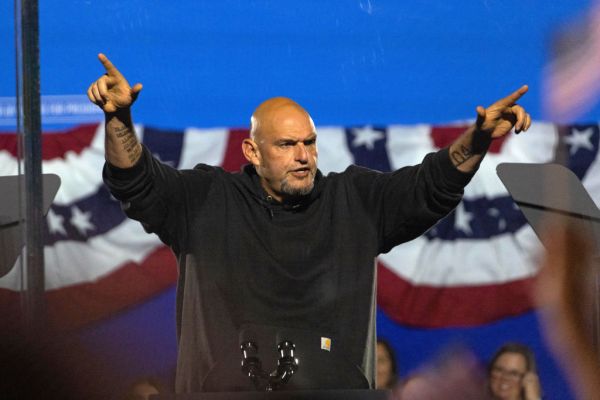Many years ago when Woody Allen was still kosher, he wrote a joke about his brother-in-law who thought he was a chicken. Cutting to the punch line, Allen confessed that the family didn’t want to take the fowl-minded brother-in-law for treatment because “we need the eggs.” Consider the tale an apt parable of America’s China dilemma. We want to cut ties, but we love the eggs.
How many times have you searched for some Amazon product, earnestly looking to ensure it isn’t a product of slave labor in China? And given up because a) it’s impossible to reckon where it came from; and b) it’s cheaper. What about Chinese state-owned companies listed on U.S. exchanges? Do you own stock? Better still, does your pension fund? Don’t know? Me neither.
Bet you were grossed out when you heard LeBron James defend the People’s Republic repression of Hong Kong. Embarrassed for your country when John Cena slobbered—in Mandarin, no less—his apologies because he called Taiwan “a country.” (For the record, it is a country, albeit one Beijing insists is part of greater China.) Did you cringe when Tom Cruise edited the patches on his Top Gun leather jacket to make sure the Taiwanese flag once there wouldn’t offend his Chinese overlords? Groan when Nike CEO John Donahoe called Nike a “brand of China and for China”?
Were you shocked by that New York Times story about the Chinese breeding a nation of social media Manchurian candidates, all of whom parrot the same praise about their lives under the Chinese Communist Party? By the arrest of Hong Kong press magnate Jimmy Lai? The concentration camps in Xinjiang? Chinese domination of the World Health Organization? COVID?
And don’t forget all the things you don’t know, can’t pay attention to. The Chinese solar panels that will fuel the Biden administration’s energy revolution; the rare earths that form your solar windmills; the Teslas built in China; the iPhones; and don’t forget polysilicon. What is it? It’s the key component in solar panels, batteries, semiconductors and more. Where does it come from? Oh yeah, mostly Xinjiang. Where the concentration camps are. And there are thousands more pieces of the global supply chain that most humans wouldn’t recognize that also come from the PRC: Your ibuprofen; your antibiotics; your car parts; and all that stuff at Target, Walmart, and of course, on Amazon.
The idea behind enmeshing Communist China in global markets was that the silken fetters of global trade would bind Beijing into the “civilized world,” making it impossible to flout norms (like not putting people in concentration camps). Instead, the fetters have bound the rest of the world to China, and forced people like Nike CEO Donahoe to bow and scrape to the Chinese, pretending all the while that there’s nothing to see here. Successive generations of American diplomats insisted there was a great role for China to play on the global stage—as a “responsible stakeholder”—even as Beijing’s dictators crushed their enemies, small-d democrats, private entrepreneurs, and families who dared to have more than the dictated one child.
Still, there is progress being made. Donald Trump effectively sounded the alarm about Chinese behavior on the global stage, and Joe Biden has continued his policies. Both made progress in persuading America’s European allies that allowing Huawei to own communications infrastructure was unwise; that the Belt and Road Initiative is not a brilliant global infrastructure venture; that mouthing “never again” while watching the wholesale incarceration and “reeducation” of Uyghur Muslims is wrong-headed. But there is much more to do.
At the personal level, customers can begin to demand information about the provenance of their purchases. It’s not imperative to buy Chinese. Amazon should include a standard—and prominent—“made in” line that tells us a product’s origins. Investors should demand that their pension funds divest from companies sanctioned by the United States for complicity in human rights violations. Take a look at your 401(k). If you care about fossil fuels enough to divest from Exxon, think about a million human souls and divest from Baidu, too. If you care enough about the free press to denounce Fox News or MSNBC, think about Hong Kong and its closure of Apple Daily, and divest from Tencent. Or Alibaba.
Congress has enormous power, too. Why should Chinese state-owned companies have free access to U.S. capital markets? Chinese Uber/Lyft – Didi Chuxing – is about to close a $4 billion IPO. Congress can mandate that the SEC provide warnings about the risks of investing in non-market economies and companies. Congress can stop U.S. government pension funds from making those same investments (lawmakers talk big, but it hasn’t happened).
China has generated enormous influence in small nations with debt trap diplomacy in the form of its Belt and Road Initiative. But countries that want to write checks to Beijing shouldn’t be getting aid from the U.S. taxpayer. It should be a choice. If China wants its candidates to run U.N. agencies (and follow Beijing’s diktat), the United States can bow out or work harder to field better candidates.
If China wants to engage, Iran-style, in hostage diplomacy and hold innocents in its execrable prisons – as it does with Canadians Michael Kovrig and Michael Spavor – then the United States should warn its nationals not to travel to the People’s Republic. It is too dangerous. If China wants to extort subservience from Australia, sanctioning everything from its wine to its timber, then the United States and Europe should develop a concerted campaign to buy Australian.
All told, the Chinese Communist Party that rules with an increasingly iron fist, that is slowly swallowing its “near abroad,” that is threatening democratic Taiwan and has already crushed Hong Kong, has paid a stunningly small price for its predations. At an individual level, a legislative level, the national level and the supranational allied level there is a great deal more that can be done to push back. Choices must be made; in truth, we do not need the eggs.






Please note that we at The Dispatch hold ourselves, our work, and our commenters to a higher standard than other places on the internet. We welcome comments that foster genuine debate or discussion—including comments critical of us or our work—but responses that include ad hominem attacks on fellow Dispatch members or are intended to stoke fear and anger may be moderated.
You are currently using a limited time guest pass and do not have access to commenting. Consider subscribing to join the conversation.
With your membership, you only have the ability to comment on The Morning Dispatch articles. Consider upgrading to join the conversation everywhere.